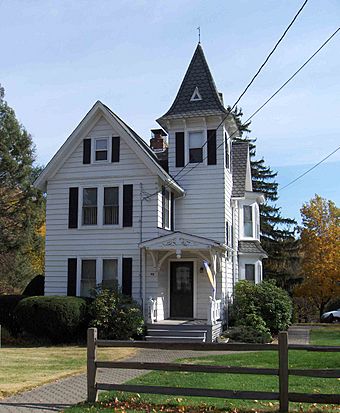Marion, Connecticut facts for kids
Quick facts for kids |
|
|
Marion Historic District
|
|

Lester Beecher House (1166 Marion)
|
|
| Location | Along Marion Ave. and the Meriden-Waterbury Turnpike, Cheshire (New Haven County) and Southington (Hartford County), Connecticut |
|---|---|
| Architect | Multiple |
| Architectural style | Greek Revival, Italianate, Federal |
| NRHP reference No. | 88001423 |
| Added to NRHP | December 21, 1988 |
Marion is a neighborhood in the town of Southington, Connecticut. It's located near where Route 322 and Marion Avenue meet. This area is just north of the Cheshire town line.
The neighborhood is home to the Marion Historic District. This special area is listed on the National Register of Historic Places. This means its buildings and history are important to the country.
Contents
Marion's Post Office
There has been a post office in Marion since the 1800s. It got its name "Marion" because some local children had moved to Marion, Alabama. Even though there's a post office, regular mail for the Marion neighborhood uses the Plantsville, Connecticut address. The Marion ZIP code is only for post office boxes.
A Look at Marion's History
Marion started as a farming community in 1739. This was when the land was measured and divided. At that time, Southington was part of Farmington. The area was first called "Little Plain." It stretched from French Hill down to the Cheshire town line.
The soil in Little Plain was great for farming. This was because it was near a high ridge. Farms from the 1700s were built along a main road. This road went from Bristol to New Haven. Today, this road is Marion Avenue.
Marion During the Revolutionary War
During the American Revolutionary War, French General Jean-Baptiste Donatien de Vimeur, comte de Rochambeau and his soldiers camped in Marion. In June 1781, the French troops marched about 13 miles (21 km) from Farmington. Marion was their eighth camp on their journey through Connecticut. They stayed in the area for four days.
General Rochambeau and his officers stayed at Asa Barns' tavern. The soldiers set up their camp on a hill across the road. This area is now known as French Hill. A marker on Marion Avenue remembers the French campsite. Rochambeau visited the tavern again in October 1782 on his way back.
In 1987, the Asa Barns tavern became a protected site. It was added to the National Register of Historic Places. This was because of its important history and architecture. The building is now a private home.
Growth and Industry in Marion
In 1813, the Meriden-Waterbury Turnpike was built through Marion. This made the community a busy crossroads. Small factories began to appear in the 1800s. For example, L.B. Frost and Son started making carriage bolts and nuts in 1842. They used the water power from Humiston Brook.
In more recent times, Marion has become a suburban community. This means it has many homes and is part of a larger city area. Suburban growth began in 1914 when a trolley line was built. This line connected Marion to the city of Waterbury. The area continued to grow in the years that followed. There was especially strong growth from the late 1960s through the late 1980s.
Marion's Historic District
The Marion Historic District was officially listed on the National Register of Historic Places on December 21, 1988. The Connecticut Historical Commission suggested it in July 1988. The district was chosen because it has many well-preserved buildings. These buildings are from the 1700s, 1800s, and early 1900s. Together, they show how the Marion community grew over time.
The buildings in the district show three main periods of Marion's history:
- Early Farming: From about 1770 to 1842.
- 1800s Industry and Growth: From 1842 to 1900.
- Early Suburban Growth: From 1914 to 1938.
Important Buildings in the District
The historic district includes 34 main important buildings. Two of these are actually in the town of Cheshire. The buildings show different styles of architecture. These include Greek Revival, Italianate, and Federal styles.
Some of the most important buildings are:
- Asa Barnes Tavern (also known as Levi B. Frost House), located at 1089 Marion Avenue. This building is now a private home. It was added to the National Register of Historic Places in 1987.
- Barnes-Frost House
- Miles Upson House, at 1316 Marion Avenue. This is a one-story house. It might be the oldest house in the district that still looks like it did originally.
- The Lester Beecher House, at 1166 Marion Avenue. This house has a unique shape and a three-story tower. It is an example of the Queen Anne style.
Images for kids






